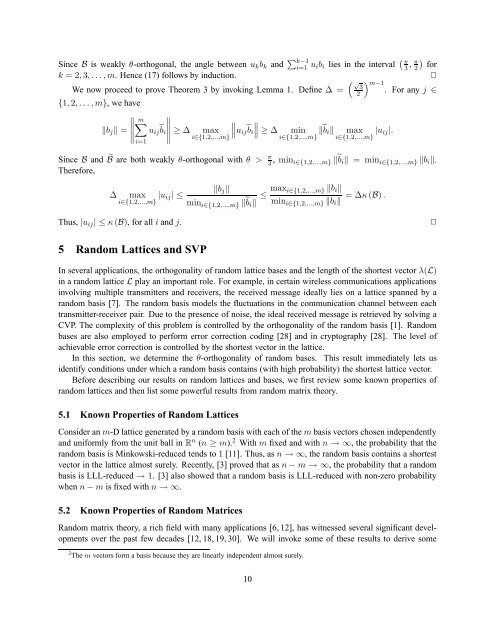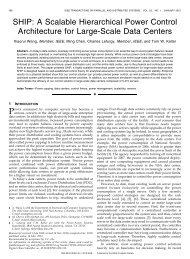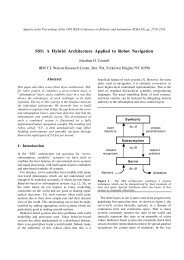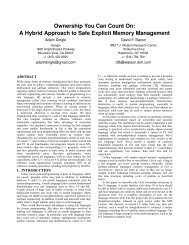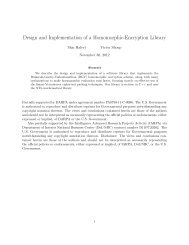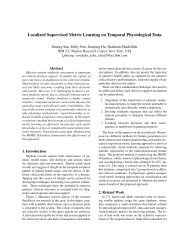On Nearly Orthogonal Lattice Bases and ... - Researcher - IBM
On Nearly Orthogonal Lattice Bases and ... - Researcher - IBM
On Nearly Orthogonal Lattice Bases and ... - Researcher - IBM
You also want an ePaper? Increase the reach of your titles
YUMPU automatically turns print PDFs into web optimized ePapers that Google loves.
Since B is weakly θ-orthogonal, the angle between u k b k <strong>and</strong> ∑ k−1i=1 u ib i lies in the interval ( π3 , π 2)fork = 2,3,... ,m. Hence (17) follows by induction.✷( √3 ) m−1.We now proceed to prove Theorem 3 by invoking Lemma 1. Define ∆ =For any j ∈{1,2,... ,m}, we have∥ m∑ ∥∥∥∥‖b j ‖ =u∥ ij˜bi ≥ ∆i=1maxi∈{1,2,...,m}∥∥ ∥∥∥u ij˜bi ≥ ∆ min ‖˜b i ‖ max |u ij|.i∈{1,2,...,m} i∈{1,2,...,m}Since B <strong>and</strong> ˜B are both weakly θ-orthogonal with θ > π 3 , min i∈{1,2,...,m} ‖˜b i ‖ = min i∈{1,2,...,m} ‖b i ‖.Therefore,∆ max |u ij| ≤i∈{1,2,...,m}‖b j ‖min i∈{1,2,...,m} ‖˜b i ‖ ≤ max i∈{1,2,...,m} ‖b i ‖min i∈{1,2,...,m} ‖b i ‖ = ∆κ(B).2Thus, |u ij | ≤ κ(B), for all i <strong>and</strong> j.✷5 R<strong>and</strong>om <strong>Lattice</strong>s <strong>and</strong> SVPIn several applications, the orthogonality of r<strong>and</strong>om lattice bases <strong>and</strong> the length of the shortest vector λ(L)in a r<strong>and</strong>om lattice L play an important role. For example, in certain wireless communications applicationsinvolving multiple transmitters <strong>and</strong> receivers, the received message ideally lies on a lattice spanned by ar<strong>and</strong>om basis [7]. The r<strong>and</strong>om basis models the fluctuations in the communication channel between eachtransmitter-receiver pair. Due to the presence of noise, the ideal received message is retrieved by solving aCVP. The complexity of this problem is controlled by the orthogonality of the r<strong>and</strong>om basis [1]. R<strong>and</strong>ombases are also employed to perform error correction coding [28] <strong>and</strong> in cryptography [28]. The level ofachievable error correction is controlled by the shortest vector in the lattice.In this section, we determine the θ-orthogonality of r<strong>and</strong>om bases. This result immediately lets usidentify conditions under which a r<strong>and</strong>om basis contains (with high probability) the shortest lattice vector.Before describing our results on r<strong>and</strong>om lattices <strong>and</strong> bases, we first review some known properties ofr<strong>and</strong>om lattices <strong>and</strong> then list some powerful results from r<strong>and</strong>om matrix theory.5.1 Known Properties of R<strong>and</strong>om <strong>Lattice</strong>sConsider an m-D lattice generated by a r<strong>and</strong>om basis with each of the m basis vectors chosen independently<strong>and</strong> uniformly from the unit ball in R n (n ≥ m). 2 With m fixed <strong>and</strong> with n → ∞, the probability that ther<strong>and</strong>om basis is Minkowski-reduced tends to 1 [11]. Thus, as n → ∞, the r<strong>and</strong>om basis contains a shortestvector in the lattice almost surely. Recently, [3] proved that as n − m → ∞, the probability that a r<strong>and</strong>ombasis is LLL-reduced → 1. [3] also showed that a r<strong>and</strong>om basis is LLL-reduced with non-zero probabilitywhen n − m is fixed with n → ∞.5.2 Known Properties of R<strong>and</strong>om MatricesR<strong>and</strong>om matrix theory, a rich field with many applications [6, 12], has witnessed several significant developmentsover the past few decades [12, 18, 19, 30]. We will invoke some of these results to derive some2 The m vectors form a basis because they are linearly independent almost surely.10


